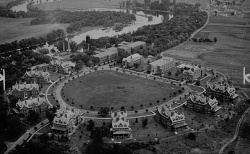Anoka State Hospital
| Anoka State Hospital | |
|---|---|
 | |
| Opened | 1900 |
| Closed | 1999 (Original campus) |
| Current Status | Active |
| Building Style | Cottage Plan |
| Location | Anoka, MN |
| Alternate Names |
|
History
Anoka-Metro Regional Treatment Center is the current name of what was originally the First State Asylum for the Insane (1900-1919), Anoka State Asylum (1919-1937), and Anoka State Hospital (1937-1985). The first 100 patients arrived at the newly opened Anoka Asylum in March 1900. The group of men who traveled by train from the St. Peter hospital were classified as “incurables.” The asylum was not built originally as a place for treatment. Rather it was where most of these men would live out their days. According to historical records, 86 of those first 100 patients died there and many were buried in numbered graves at the cemetery on the grounds.
By 1906, 115 female patients had been transferred to the hospital from the facility in St. Peter. In 1909, it was decided that Anoka would admit only female transfer patients and that the state hospital in Hastings would admit the male transfer patients. However, construction of an additional building in 1925 allowed the hospital once again to admit male patients.
As treatment of the mentally ill evolved, so did conditions and treatment at Anoka. Among the procedures performed in the 1940s and ’50s were lobotomies, some done at the University of Minnesota. In the 1950s, treatments included electroshock therapy and hydrotherapy. In 1948, Gov. Luther Youngdahl allowed a reporter and a photographer from the Minneapolis Tribune to tour the state’s seven hospitals, including Anoka. The articles that followed exposed harsh conditions. In 1949, Youngdahl visited the Anoka hospital on Halloween night and, using a torch, burned hundreds of leather restraints and straitjackets in front of a crowd of more than 1,000. In a speech, the governor said the burning “liberated patients from barbarous devices and the approach which these devices symbolized,” according to historical accounts. Youngdahl moved to improve funding and conditions in the state’s hospitals.
An infirmary and clinic are provided for the physical health care of all residents at the hospital. Any previous programs, a treatment center for the mentally ill with tuberculosis (1948-1967) as well as programs for emotionally disturbed children and adolescents (1970s), have been discontinued. “Deinstitutionalization” of the mentally ill starting in the 1960s also ushered in an era of change across the nation. At the Anoka center, the number of patients dropped from 1,085 in 1960 to 476 by 1970 as the state invested in community-based care.
A shocking event occurred in 1976, when a patient escaped hospital grounds, broke into a nearby home and killed homeowner Mary Galbraith. At packed community meetings, there were demands ranging from better security at the hospital to closing it. Compromises were reached and the hospital remained open. City police took over security in 1986. After the hospital was closed in 1999, the state gave the historic campus to Anoka County, which now uses several of the buildings to house human services offices and the county workhouse. Several of the older buildings are mothballed. The current facility, Anoka-Metro Regional Treatment Center, is located to the original Anoka State Hospital campus.
Images
Cemetery
Through the efforts of the advocacy group, a large number of headstones were initially placed which included the person's name. The hospital records indicate 400 people were buried in the cemetery from the time it opened in 1900 until the last burial in 1965. In October 2008 the advocacy group Remembering With Dignity and the Anoka Metro Regional Treatment Center hosted a special service at the cemetery site. The project was completed in 2009 and now each person has a proper marker and dignified place of rest.




